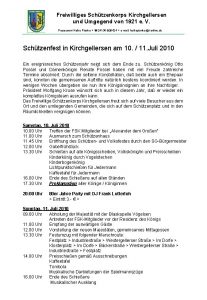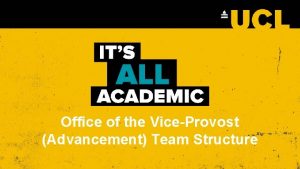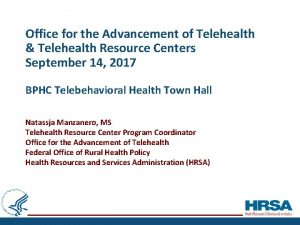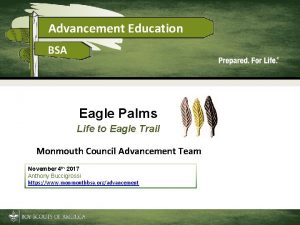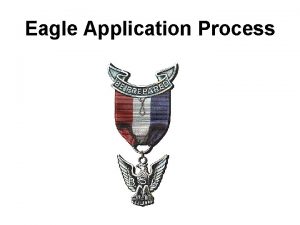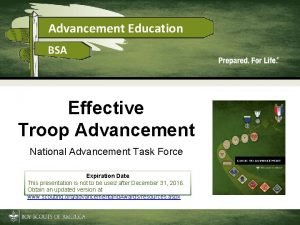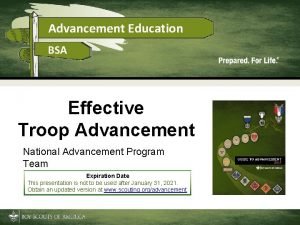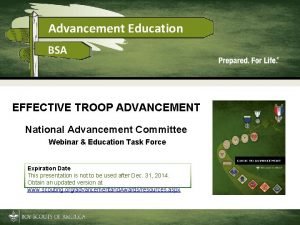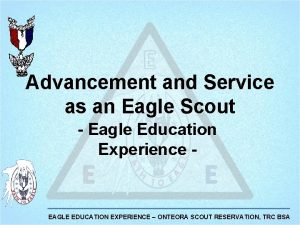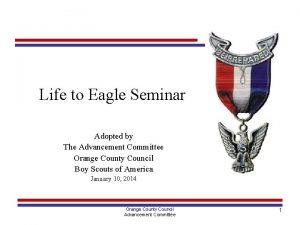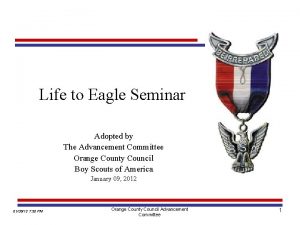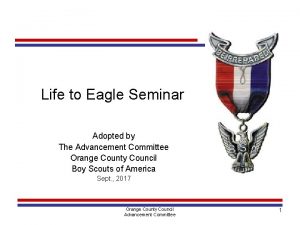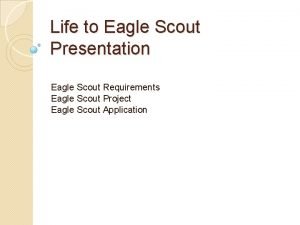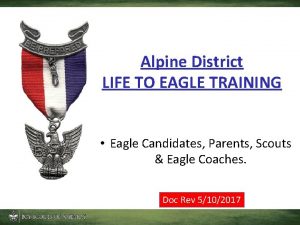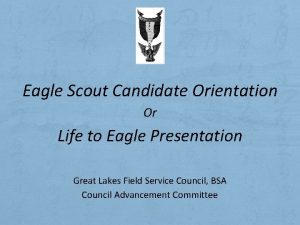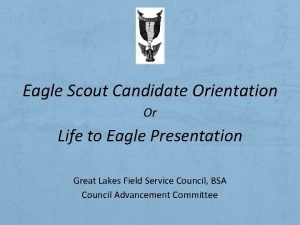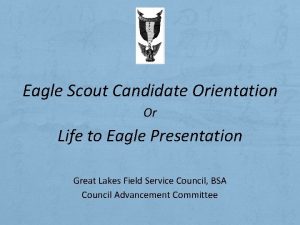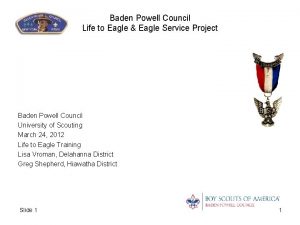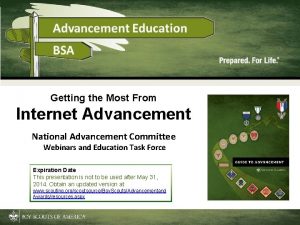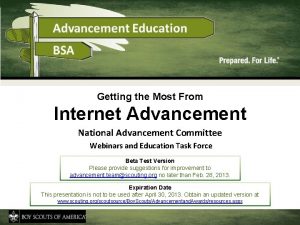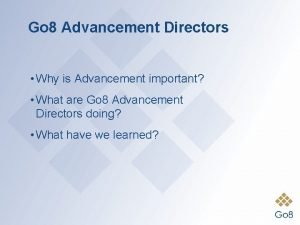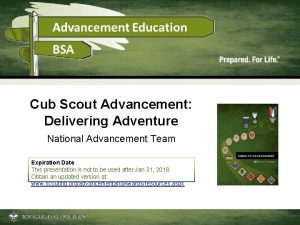Life to Eagle Advancement Process Jim Kruse Eagle









































- Slides: 41

Life to Eagle Advancement Process Jim Kruse Eagle Scout, Class of 1971 Los Amigos District Eagle Program Chairman kruse 1016@gmail. com (714) 287 -0943

Agenda • • • Introductory Remarks What does it mean to be an Eagle Scout? What role should parents play? BSA requirements for Eagle rank Eagle Scout leadership service project Q & A and discussion

Introductory Remarks • Earning the rank of Eagle Scout is a special accomplishment. Only around 4 -5% of Scouts earn this distinction each year. • Over 2 million American Boy Scouts have earned the Eagle Rank since 1912. • Famous Eagle Scouts include: – – – Gerald Ford, 38 th President of the USA Neil Armstrong, first man to walk on the moon Michael Bloomberg, Former Mayor of New York City Stephen Spielberg, Film Director and Producer J. W. Marriott, President, Marriott Corporation Bill Bennett, former Secretary of Education

What does it mean to be an Eagle Scout? There are two parts to the Eagle Scout rank: • Requirements of the rank – • “checking off the boxes” Philosophy of the rank – – Adopting the Scout Oath and Scout Law as your personal ethic, a “code to live by” Achieving Eagle Scout transcends the idea of “rank” and speaks to how you intend to live your life Making Eagle to get into college or get a better job should not be your reasons for seeking this rank Becoming a man of character should be your goal

What role should parents play? • Parents should: – – – • Ensure your son completely reviews the OCC Life to Eagle packet. Encourage your son to pick a project that meets his abilities and interests. Provide encouragement and timely reminders, as necessary. Provide technical assistance, transportation, tools, materials, and limited labor. Discuss problems and suggest solutions. Parents should not: – – – Push your son into a project he doesn’t like. Do any of the planning or the writing. Take over your son’s project to ensure success.

BSA requirements for Eagle rank 1. Be active in your troop and patrol for at least six months as a Life Scout. 2. Demonstrate Scout spirit by living the Scout Oath (Promise) and Scout Law in your everyday life. 3. Earn at least 21 Merit Badges (including the 13 Eagle-required MBs) 4. While a Life Scout, serve actively for a period of six months in one or more of positions of responsibility. 5. While a Life Scout, plan, develop, and give leadership to others in a service project helpful to any religious institution, any school, or your community. 6. Take part in a Unit Leader Conference. 7. Successfully complete an Eagle Scout board of review. NOTE: First six requirements must be completed prior to the Scout’s 18 th birthday. No Council, District, Unit or Individual has the authority to add to or subtract from any BSA advancement requirement.

Completing the Eagle Application • Obtain and complete the most recent Eagle Scout Rank Application from the Council website – Contact the Council to obtain your Scouting and Advancement history records. – All dates for advancement, merit badges etc. must match council records. If discrepancies exists, work with the unit advancement chairman to get them corrected. • Provide five or six references who know you personally and can attest that you live by Scout Oath and Law. • Compose a one to two page Statement of Life Purpose • Review completed application with your advisor • Sign application and obtain signature of the Unit Leader and Committee Chairman

#1 – Be active in your unit for at least 6 months as a Life Scout • 3 sequential tests to determine if requirements has been met: – Scout is registered – Scout is in good standing (not dismissed for disciplinary reasons) – Scout meets the unit’s reasonable expectations; or if not, a lesser level of activity is explained (other positive endeavors) • Discuss the concept of “active” with your Unit Leader and come to an agreement. • Being active will enhance your ability to demonstrate Scout Spirit.

#2 – Demonstrate Scout Spirit • “Scout Spirit” is simple in concept: “Live by the Scout Oath and Law in your everyday life. – Honor your God and your country. – Extend your helping hand to others. – Steadfastly improve yourself in body, mind, and principle. – Live the 12 points of the Scout Law • Ultimately, the decision to recommend a Scout for Eagle rank will be based on evidence of Scout Spirit. – Unit Leader signs off on this important component. – The Eagle application asks for references who know the Scout personally and can attest that he lives by the principles of the Scout Oath and Law. – The Eagle Board of Review will confirm that you show “Scout Spirit”

#3 – Earn a total of 21 merit badges • 13 required merit badges – First Aid Communications – Citizenship in the Community Citizenship in the Nation – Citizenship in the World -- Family Life – Personal Fitness Emergency Preparedness or Lifesaving --Personal Management -- Cooking – Swimming or Hiking or Cycling --Camping – Environmental Science or Sustainability • Some required merit badges (italicized in red) have mandatory time periods and should not be delayed. • Merit badges earned beyond the 21 required MAY qualify for Eagle Palms. • Keep records on merit badges earned – – • Retain Scout portion of each blue card in sports card holders Periodically compare blue card records to troop and council records, and act immediately to correct discrepancies There are special exceptions for Scouts with disabilities

#4 – While a Life Scout, serve actively for a period of six months in one or more positions of responsibility: • Discuss the term “serve actively” with your Unit Leader and come to an agreement. • All Life Scouts must obtain Unit Leader approval before taking a leadership position. • Time carried on the unit records in the position is all that may be required. • Scout does not have to hold one position for six (6) months. • Scout does not have to hold the position for six (6) consecutive months. • Scout may meet this requirement any time while a Life Scout prior to his 18 th birthday.

#4 – While a Life Scout, serve actively for a period of six months in one or more positions of responsibility (continued): • Eligible leadership positions include: • Boy Scout troop: Patrol leader, assistant senior patrol leader, troop guide, Order of the Arrow troop representative, den chief, scribe, librarian, historian, quartermaster, junior assistant Scoutmaster, chaplain aide, instructor, webmaster, or outdoor ethics guide. • Varsity Scout team: Captain, co-captain, program manager, squad leader, team secretary, Order of the Arrow team representative, librarian, historian, quartermaster, chaplain aide, instructor, den chief, webmaster, or outdoor ethics guide. • Venturing crew/ship: President, vice president, secretary, treasurer, quartermaster, historian, den chief, guide, boatswain's mate, yeoman, purser, storekeeper, webmaster.

#5 – While a Life Scout, plan, develop, and give leadership to others in a service project helpful to any religious institution, any school, or your community. More to come later in the presentation!

#6 – Take part in a Unit Leader conference • Make an appointment with your Unit Leader • Dress in full uniform, and bring your completed Eagle Application, Project Workbook, and Handbook • The conference is not a “test” that you must pass • Goals of the conference: – Unit Leader will discuss your readiness to advance to the rank of Eagle Scout – Unit Leader will discuss Scout Spirit, and, if satisfied, sign your Handbook and the Eagle Application

#7. 1 – Complete an Eagle Board of Review: Preparing for the Review • It is recommended that you distribute “Eagle Scout Appraisal forms (see Life to Eagle Packet) to the references you listed on your Eagle Application. – Parent --Educator – Employer --Two “friends” (over 21 years of age) – Religious Leader (see comment below) • If you are not active in a religious organization, or are unfamiliar with your religious leader, you may wish to write a statement of your religious beliefs, signed by you and your parents. Discuss with your advisor. • References must be timely…within three months or less of the date of your Eagle Application.

#7. 2 – Complete an Eagle Board of Review: How to initiate a Board of Review • Work with your District Advisor to schedule your Eagle Board of Review • Your District Advisor, working with your unit’s Committee Chairman, will select board members: – Volunteer Adults (No Unit Leaders and Assistant Unit Leaders) – District representatives – Members of the community such as teachers, principals, coaches, counselors, clergy, family friends (over 21) – Scouts are to have NO input into the board’s composition • Your District Advisor will schedule the review, or he/she may ask your unit to assist in scheduling the review. • Your Unit Leader may attend to introduce you to the board, and he may stay to observe, but he cannot participate in the review.

#7. 3 – Complete an Eagle Board of Review • Board has no less than three members and no more than six. • You will be asked to recite the Scout Oath, Scout Law, Scout Slogan and Scout Motto from memory at the onset of the review. • You may be asked to discuss the meaning of The Outdoor Code. • Reviews are wide ranging and typically encompass: – The meaning of the Scout Oath and Law, and how you “live” them in your daily life. – A review of all aspects of your Eagle Project including leadership – A review of your leadership experiences in the troop – How Scouting has affected your life – What it means to be an Eagle Scout • Typical duration is 30 minutes after which the board meets privately to decide whether you have met the requirements. • Decisions must be unanimous. Appeal process is available. • If you pass, your District Advisor submits the paperwork recommending you for Eagle Scout to the BSA National Office for final approval. This process takes from two to four weeks.

Concluding comments • The key elements in reaching Eagle rank are your initiative, active involvement and perseverance. • The troop and your parents can help but ultimately the achievement and recognition are yours. • Create a plan for reaching Eagle as soon as you achieve the Life Scout rank. – Remain active in troop and patrol activities – Identify and complete an Eagle Leadership Service Project – Identify and complete a leadership role that is interesting to you – Complete your merit badges

Eagle Scout Service Project While a Life Scout, plan, develop, and give leadership to others in a service project helpful to any religious institution, school, or your community.

Understanding the purposes of the project • Leadership: it is about your ability to work with and organize others to complete a successful project • Service: the project should make a material contribution to a community-based, non-profit organization • Skills development: the project will test your skills in § – Planning – Communications – Project management – Managing and dealing with lots of different people and organizations Initiative: putting your Scouting skills to work on a project for which you are responsible from concept to completion

Timing is Everything! • Decide when you want to get the project completed. – You can start the project anytime after you become a Life Scout – Ideally, you should plan to complete the Eagle project no later than the summer before your junior year in high school. • § Plan ahead so that you can find a time when the Eagle project can be balanced with: – Schoolwork – Sports and other commitments – Vacations and holiday schedules (yours and others) Set a deadline for completing the project and stick with it.

Getting organized • Download and review the “Life to Eagle” packet from the Orange County Council Advancement website: – http: //www. ocbsa. org/lifetoeaglepacket/ • You may start planning your Eagle Scout Service Project any time after achieving the rank of Life Scout. • All work on your Eagle Scout Service Project must be undertaken while you are a Life Scout and completed before your 18 th birthday. • If you are in Los Amigos District, contact Mr. Kruse if you want a District Advisor/Project Coach, otherwise, contact your District Advancement Chairman.

What makes for a good Eagle Project? • Must be a project that conforms to the wishes and regulations of those for whom the project is undertaken. • Must be where the Eagle Scout demonstrates leadership skills learned in Scouting. • Must be done outside the sphere of Scouting (not a Unit function). • Must be planned, organized, staffed, and directed to completion by the Scout. • Must not be routine labor or a job normally rendered.

What makes for a good Eagle Project? (continued) • There is no minimum or maximum number of volunteers or hours of work needed to carry out your Eagle Scout Service Project. • Proposal approval by the project beneficiary, your Unit Leader, Unit Committee and District Representative must be obtained in writing before you begin. • The Project may not: • Involve BSA properties • Be performed for a business • Be of a commercial nature • Be routine labor or maintenance • Be for the benefit of an individual

What makes for a good Eagle Project? (continued) • A candidate may not use his participation in the project of another Eagle candidate to satisfy the Eagle Scout Service Project requirement. • You may not copy or otherwise share your responsibilities for planning, developing or providing leadership to others • The amount of time spent must be sufficient for the Scout to demonstrate his leadership skills. • Although the project idea must be approved before work is begun, the Board of Review must determine the manner in which the project was carried out. The following must be answered: • • • In what ways did you demonstrate leadership? Give examples of how you directed the project rather than doing the work yourself. In what way did the sponsor benefit from the project? Did the project follow the plan? If changes to the plan were made, explain why the changes were necessary.

Picking a project • Start by talking with: – – Your favorite teachers Volunteer coordinators at non-profit organizations Your religious leader Other Scouts who have completed their projects • Web search using key words “Eagle Project” • Remember that any project involving a government agency will always take longer and may be more complicated. • Make sure your project sponsor has the sole authority to authorize the project. • Review your idea with your District Advisor to make sure it fulfills the requirements

Planning the project Planning is the most important part of any successful Eagle project, and it takes time! • Keep accurate inventory records and a log of work activities • Manage the resources and purposefully direct the project to its completion. A completed project plan will address the following: • How much will the project cost? • Price out all materials • Tools may be borrowed or rented • Don’t forget refreshments for your helpers!

Planning the project (continued) A completed project plan will address the following: • • Does the sponsoring organization qualify for an Eagle project? – Non-profit – Non-BSA – Broad benefit to community Is the project appropriate? – Not too large or too small – Not a maintenance or routine labor project – Enables you to demonstrate leadership – Reflects well on Scouting and you

Planning the project (continued) Fund Raising: • Fund raising is permitted only for the purpose of acquiring the materials and supplies needed to carry out your project. • Fundraising is not a requirement. • Fundraising must not be a part of the objectives of the project itself. • Fund raising must conform to the Guide to Safe Scouting (Tour Plans when appropriate, parental consent, supervision and most important, safety). • You may solicit donations of materials from local retail or wholesale companies. • Your sponsoring agency may have funding available. • Projects requiring large sums of money should be avoided.

Planning the project (continued) Fund Raising (continued): • Any project fundraising effort that is expected to raise less than $1000. 00 from other than exempt parties (the candidate, his parents, his relatives, his unit or its chartered organization, parents or members of his unit, or the beneficiary) does not require a Fundraising Application. There are no limits on funds raised from exempt parties. • Projects that are expected to raise more than $1000. 00 (except from exempt parties) must utilize the Eagle Scout Service Project Fundraising Application. This $1000. 00 limit of nonexempt funds applies to the total of cash and gifts in kind. • Funds raised (except funds from exempt parties) must be held by and disbursed from the unit treasury.

Planning the project (continued) A completed project plan will address the following: • What is your project plan? A good plan should include: – Lists of tasks and # hours estimated for each through completion – Spreadsheets with estimated hours and costs – Drawings and designs to show what you intend to do • • How will you ensure that the project is carried out safely? – Adult supervision needs to be “two deep” with one Youth Protection Trained adult present at all times – Use of power tools: Adults must be the users of power tools unless they conduct a training session with youth volunteers Your project plan should convince the reader that the service project will be successful for everyone involved.

Planning the project (continued) About the Beneficiary: • The Board of Review will expect your Eagle Scout Service Project to be helpful and of significance to the beneficiary for whom it is undertaken. • The project must benefit an organization other than Boy Scouting. • You MAY do a project for your Unit Charter Partner or Sponsor if it meets other requirements. • Beneficiaries may be any religious institution, any school, or your community. • A community organization is defined as just about any nonprofit group that can supply a beneficiary.

Planning the project (continued) Project Coach (District Advisor): • It is strongly recommended that you obtain the services of a Project Coach to work with you in developing your Eagle Scout Project Final Plan. • The coach can only recommend; not require. You make the final decisions. • The coach will provide valuable insights for a successful project.

Using the Eagle Scout Service Project Workbook Use the Eagle Scout Service Project Workbook in meeting this requirement • Eagle Scout Service Project Workbook No. 512 -927 • Websites to download the workbook: • – http: //www. NESA. org – http: //www. ocbsa. org/lifetoeaglepacket/ Always ensure you are using the most current version!

Using the Project Workbook (continued) Project Proposal • Describe project broadly • Identify the Beneficiary • Approval signatures Project Plan • Create a detailed plan • Material, time, labor • Leadership Fundraising Application • • Approved by District $1, 000 threshold rules Exemptions apply Unit holds project funds Project Report • • • Post-project review Observations Changes Leadership discussion Approval signatures

Project Workbook Approval Signatures Project Proposal (Before you start the Eagle Project): • Beneficiary • Unit Leader • Unit Committee Chairman • District Eagle Advisor/Project Coach Project Report (After the project is completed): • Eagle Candidate • Beneficiary • Unit Leader

Carrying out the project • Set a schedule for completing the project and stick to it • Do a job that you are proud of and reflects well upon Scouting – On time: keep momentum to finish the project, including write-up – On budget: see how your estimates compare to your actuals – Quality work: Is Scouting well represented? • Ensure that you are managing others and not conducting the project yourself (this may mean managing adults as well). • People are more likely to help on your project if: • – You are active in the troop – You help out on other Eagle projects Non-Scouts are welcome to help out on Eagle projects Have fun. You should be able to look at the Eagle project as one of your most enjoyable experiences in Scouting.

Keep people up to date • Keep the project sponsor, your unit leader, and the District Advisor up to date on your progress. Leave messages!! • Ask for help when you hit roadblocks. • As the project progresses, have it inspected by the project sponsor and, if necessary, the District Advisor. • Avoid the “dead zone” between completing the project and completing the write-up (you should be doing the write-up as you do the project).

Extensions You may file a petition in writing for special permission to continue to work toward the award after reaching age 18, BUT: • The petition will be reviewed by the Orange County Council Advancement Committee. • The petition must show good and sufficient evidence and detail extenuating circumstances • Extenuating circumstances are defined as conditions or situations that are totally beyond the control of the Scout • Busy is NOT an excuse! Late is NOT an excuse!

Eagle Myths Debunked! Some examples of Eagle Myths: • Cannot receive help from parents • The project must involve construction • Detailed drawings to scale (CAD/3 D) must be included • Cannot involve any volunteers from outside the unit • Must include multi-media presentations • The project must be completed within 30 days • The project must be completed as the last requirement • The project write-up must be done in such a way that any other Scout could complete it • The Scout must be a certain age before beginning work • The project must have a minimum of 200 hours • Extensions are easy to get…you just have to ask

Questions? Comments? Concerns? Every question is a good question. The only “dumb” question is the one you don’t ask.
 Kruše života ljubavi vir
Kruše života ljubavi vir Kruše života ljubavi vir
Kruše života ljubavi vir Jedan kruh na svetom stolu
Jedan kruh na svetom stolu Kruše života ljubavi vir
Kruše života ljubavi vir Kruse mennillo
Kruse mennillo Rudolf kruse
Rudolf kruse Ak čudesa tražiš pjesma tekst
Ak čudesa tražiš pjesma tekst Nas bog on je silan bog i kralj tekst
Nas bog on je silan bog i kralj tekst Rene kruse
Rene kruse Vogelstechen
Vogelstechen Jesper kruse markvart
Jesper kruse markvart Darren kruse
Darren kruse Tadd kruse
Tadd kruse Cade kruse
Cade kruse Revenue recognition pwc
Revenue recognition pwc Congenital sinus example
Congenital sinus example Casis
Casis Insall salvati ratio
Insall salvati ratio Advancement office structure
Advancement office structure Office for the advancement of telehealth
Office for the advancement of telehealth Holistic advancement meaning
Holistic advancement meaning Holistic advancement meaning
Holistic advancement meaning Uf advancement
Uf advancement Advancement in medicine
Advancement in medicine How are vowels classified
How are vowels classified Professional advancement in nursing
Professional advancement in nursing Dermal advancement flap
Dermal advancement flap Dental hygienist advancement opportunities
Dental hygienist advancement opportunities Association for the advancement of medical instrumentation
Association for the advancement of medical instrumentation Ge center for additive technology advancement
Ge center for additive technology advancement Scoutbook advancement sync
Scoutbook advancement sync Pharmacy advancement initiative
Pharmacy advancement initiative Nttaa
Nttaa Daf yomi advancement forum
Daf yomi advancement forum Action for social advancement (asa)
Action for social advancement (asa) Eagle plucks out beak and talons
Eagle plucks out beak and talons Jimmy meyer primerica
Jimmy meyer primerica Jim kenney harvard pilgrim
Jim kenney harvard pilgrim Jim gray database
Jim gray database The new jim crow chapter 1
The new jim crow chapter 1 The new jim crow chapter 2
The new jim crow chapter 2 Computer age
Computer age









